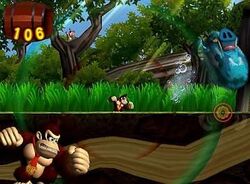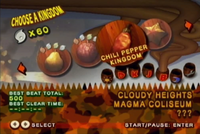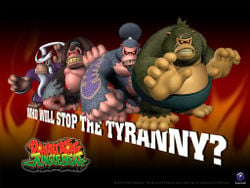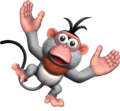Donkey Kong Jungle Beat
Template:Infobox Donkey Kong Jungle Beat is a 2.5D platformer in the Donkey Kong series for the Nintendo GameCube. The game's main gimmick stems from the use of the DK Bongos controller, previously affiliated with Donkey Konga, as the recommended controller, though a standard Nintendo GameCube controller may still be used.
Donkey Kong Jungle Beat is the first console Donkey Kong since the release of Donkey Kong Country to not be developed by Rare, since the company, which lost the rights to the Donkey Kong series due to the fact that it was trademarked by Nintendo, was bought out by Microsoft. Due to the change in developers, Donkey Kong Jungle Beat was very different than the Donkey Kong Country games in gameplay, characters, and, perhaps most notably, the personality of Donkey Kong, who is shown to be more aggressive than in past titles. This was also the first game to be given the "E10+" rating from the ESRB.
Story
Story from the New Play Control! instruction booklet:
One day, the peace of the jungle was disrupted by a rampaging pack of wild baddies who wreaked havoc on the residents of the jungle.
Not only that, but they laid claim to every kingdom and stole each one's precious bananas!
"This calls for the one and only Donkey Kong!"
Join forces with your jungle buddies to face an array of powerful enemies and restore peace to the jungle!
During the events of the game, the jungle and various fruit kingdoms are overrun by the minions of Ghastly King and Cactus King. The bananas from the jungle are also all stolen, scattered throughout the various kingdoms. Donkey Kong decides to help by facing and defeating the kings of each kingdom to both liberate the kingdoms and reclaim the bananas.
It was stated by game director Yoshiaki Koizumi in an interview in response to the game's lack of story or plot that "The only thing Donkey Kong needs is to be the best, and to become the king of the jungle."[1]
Gameplay
Donkey Kong Jungle Beat allows the player to use the special DK Bongos peripheral as the controller as well as a standard Nintendo GameCube controller. Hitting the left bongo repeatedly will send Donkey Kong running to the left, and hitting the right will send him right; holding down on the bongo causes him to walk. To jump straight into the air, the player must hit both bongos simultaneously. To jump diagonally, the player must hit the bongo in the direction he or she wants to jump while using the other bongo to run. Hitting both drums in midair causes Donkey Kong to perform a ground pound. The Jungle Buddies are also controlled by using the drums.
With a Nintendo GameCube controller, the actions performed by the bongos are mostly incorporated into the ![]() . To move, the player must tap the
. To move, the player must tap the ![]() in the desired direction in order to move Donkey Kong; holding it causes Donkey Kong to walk, and repeatedly tapping it causes him to run. To jump, the player must press
in the desired direction in order to move Donkey Kong; holding it causes Donkey Kong to walk, and repeatedly tapping it causes him to run. To jump, the player must press ![]() or tap the
or tap the ![]() upwards, and to move in midair, the player must tap the
upwards, and to move in midair, the player must tap the ![]() in the desired direction. To punch, the player must tap the
in the desired direction. To punch, the player must tap the ![]() back and forth repeatedly. Moving any of the Jungle Buddies is done once again by tapping the
back and forth repeatedly. Moving any of the Jungle Buddies is done once again by tapping the ![]() .
.
Donkey Kong is given a new move called Sound Wave Attack, which can be used by clapping into the microphone or hitting the sides of the drums when using the bongos or by tapping ![]() on a standard controller. The Sound Wave Attack consists of an outer green ring mostly used to stun enemies and an inner red ring generally used to defeat enemies and grab beats. The Sound Wave Attack can also be used for various other purposes depending on the situation.
on a standard controller. The Sound Wave Attack consists of an outer green ring mostly used to stun enemies and an inner red ring generally used to defeat enemies and grab beats. The Sound Wave Attack can also be used for various other purposes depending on the situation.
The main goal throughout most of the game is to get to the end of a stage while also trying to collect as many beats as possible. At the beginning of each kingdom, the player starts with twenty beats (two hundred in the final levels) and may obtain more by collecting the beats scattered throughout the stage and defeating enemies. These beats act as health throughout a kingdom. Losing all beats collected in a level and being damaged results in a Game Over, and the player must restart from the beginning of the kingdom. At the end of each level is a fruit, which DK must bite into to complete a level. The player can then play a minigame involving attempting to eat as many bananas as possible in a few seconds, giving them extra beats equal to the number of bananas eaten.
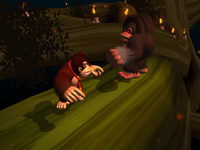
Using the clap grab move, the player can collect all the beats in a general area with one move, which increases the beat count by a greater number than by simply running into each one. In addition, combos, which are obtained by performing special actions (backflips, ground pounds, riding a Jungle Buddy, etc.), also give the player more beats than normal. When one such move is performed, a counter starts at "Combo 2", and performing additional moves increases the counter by one for each action; the counter does not increase, however, for actions performed twice during one combo. Combos increase the amount of beats earned from bananas by the combo number; in the case of banana bunches, this number is also multiplied by three. A combo continues as long as Donkey Kong is airborne and ends when he lands on the ground again; the number of beats collected during the combo is then added to the total. However, if the player is damaged while a combo is active, the player loses all the beats accumulated during the combo.
Most of the Kingdoms in the game contain three stages: two standard levels to earn beats, followed by a boss battle in which the player must deplete the boss' health bar to zero. At the end of each kingdom, the player's total remaining beat count is tallied at the Sacred Tree. By earning a certain number of beats, the player can earn up to four crests from the tree. These crests are used to unlock new kingdoms, as each one can only be unlocked when a certain number of crests have been obtained. By default, the player earns a Bronze Crest no matter how many beats they have, though the others can only be earned by collecting the following amounts of beats:
- 400 - Silver Crest
- 800 - Gold Crest
- 1200+ - Platinum Crest
Kingdoms
Donkey Kong Jungle Beat contains a total of 16 kingdoms, all of which are named after a fruit. Each kingdom also contains two levels followed by a boss battle, with the only exceptions being Opening Ceremony and the moon barrel levels (all one level each), making 50 total stages. In addition, there is the Opening Ceremony, as well as the Cactus King and Ghastly King stages, adding up to 19 total kingdoms. Kingdoms are unlocked by clearing each barrel (and in the D Barrel's case, by clearing Opening Ceremony and the Banana Kingdom), but may not be accessed until the number of crests shown on each plaque is obtained.
Each kingdom is contained within one of six "barrels", with each barrel containing four kingdoms, while the moon barrel only has two kingdoms and Opening Ceremony is in its own sun barrel. The four barrels containing the game's sixteen main kingdoms are the "D", "K", "J", and "B" barrels, the letters composing the acronym for Donkey Kong Jungle Beat.
| Barrel | Kingdom | Levels | Boss | To Unlock |
|---|---|---|---|---|
| Sun Barrel | Opening | Opening Ceremony | ||
| D Barrel | Banana Kingdom | Dawn Savana | Dread Kong | Clear Opening Ceremony. |
| Jungle Deeps | ||||
| Orange Kingdom | Silver Snow Peak | Scruff Roc | 1 Crest | |
| Sky Garden | ||||
| Watermelon Kingdom | Monkey Fest | Rogue Hog | 2 Crests | |
| Desert Oasis | ||||
| Apple Kingdom | Massive Canyon | Turret Tusk | 3 Crests | |
| Ice Warren | ||||
| K Barrel | Strawberry Kingdom | Helibird Nest | Mo-Hog | 6 Crests |
| Spirit Tree | ||||
| Pineapple Kingdom | Rumble Falls | Karate Kong | 7 Crests | |
| Pristine Sea | ||||
| Lemon Kingdom | Chopperbird Race | Fleet Roc | 8 Crests | |
| Cactus Mine | ||||
| Grape Kingdom | Sweet Paradise | Grave Tusk | 9 Crests | |
| Primeval Ruins | ||||
| J Barrel | Cherry Kingdom | Aurora Glacier | Hard Roc | 12 Crests |
| Grim Volcano | ||||
| Peach Kingdom | Arctic Plunge | Torch Tusk | 14 Crests | |
| Ancient Foundary | ||||
| Melon Kingdom | Iguanagon's Realm | Bloat-Hog | 16 Crests | |
| Banshee Swamp | ||||
| Durian Kingdom | Battle for Storm Hill | Ninja Kong | 18 Crests | |
| Arie Fortress | ||||
| B Barrel | Pear Kingdom | Deep Sea Sprint | Gloat Hog | 25 Crests |
| Clock Tower | ||||
| Lychee Kingdom | Helibird Dash | Thunder Roc | 29 Crests | |
| Lava Cavern | ||||
| Chili Pepper Kingdom | Cloudy Heights | Double Tusk | 34 Crests | |
| Magma Coliseum | ||||
| Star Fruit Kingdom | Ninjape Rally | Sumo Kong | 41 Crests | |
| Asteroid Belt | ||||
| Moon Barrel | VS. Cactus King | Cactus King | 22 Crests Clear D-J Barrels | |
| VS. Ghastly King | Ghastly King | 51 Crests Clear B Barrel |
Characters
Main
- Donkey Kong
- Helper Monkeys - Small monkeys who assist Donkey Kong in various ways throughout the game.
Jungle Buddies
Like the Donkey Kong Country games, Donkey Kong Jungle Beat features four animals to assist Donkey Kong.
| Animal | Description |
|---|---|
| Hoofer |
Hoofer the wildebeest is only found in ice-based levels. When controlling Hoofer, he continuously moves forward; the player must pound the right drum to run faster, and both to jump, like Donkey Kong. Hoofer is either found at the end of a level, or at the beginning of one, and depending on which determines what minigame is played at the end of the stage. If Hoofer is ridden from the beginning, the player must make as far a jump as possible. If Hoofer is at the end, the minigame involves jumping across as many gaps as possible. Both games earn the player additional beats. |
Flurl
|
Flurl the squirrel acts like a parachute, causing the player to slowly float downward when encountered. Flurl is controlled by pounding the drums to make him move in that direction; this also causes him to slow down. |
| Orco |
Orco the killer whale is only encountered in Pristine Sea. Orco moves along a set path, and the player can only use the Sound Wave Attack when riding him; pounding the drums causes Donkey Kong to dismount Orco. |
| Helibirds File:Helibird1.PNG |
Helibirds are first encountered in the Strawberry Kingdom and are common afterward. They are controlled by pounding the bongos in either direction to make them fly upward in that direction. |
Bosses
Donkey Kong Jungle Beat features a total of eighteen bosses. There are four basic types of bosses, one of each occupying each of the main kingdoms in one barrel, while the other two occupy the last levels. The four different types of bosses are:
- Kongs - New Kongs which fight Donkey Kong one-on-one with different fighting styles.
- Rocs - Birds which carry massive eggs that must be attacked.
- Hogs - Warthogs which throw electric coconuts that must be knocked back at them.
- Tusks - Mechanical elephants that shoot cannonballs which are defeated by throwing pineapple bombs at them.
In addition, the bosses in later barrels gain the attacks used by that type of boss in the previous barrel, and depleting a boss's HP to below half causes them to start attacking with their own additional attack.
| D Barrel | K Barrel | J Barrel | B Barrel | |
|---|---|---|---|---|
| Kongs | Dread Kong | Karate Kong | Ninja Kong | Sumo Kong |
| Tusks | Turret Tusk | Grave Tusk | Torch Tusk | Double Tusk |
| Rocs | Scruff Roc | Fleet Roc | Hard Roc | Thunder Roc |
| Hogs | Rogue-Hog | Mo-Hog | Bloat-Hog | Gloat-Hog |
| Moon Barrel | ||||
| Cactus King Ghastly King | ||||
Other
- Squids - Squids that infrequently appear in underwater levels and leave a trail of bananas as they swim away.
- Chopperbird - A man in a bird costume who races Donkey Kong in Chopperbird Race in the Lemon Kingdom.
- Turtles - Three turtles that race Donkey Kong in Deep Sea Sprint in the Pear Kingdom.
- Space Dragons - Two-ended tubes that transport Donkey Kong.
- Combo Fairies - Fairies that surround Donkey Kong when a combo is active.
Enemies
| Enemy | Image | Description |
|---|---|---|
| Iguanagon | File:Iguanagon.PNG | A massive lizard that chases Donkey Kong in Hoofer's stages. |
| Gale Hawg | 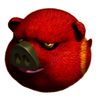
|
Red Hawgs that blow Donkey Kong away when he gets close. |
| Nap Butapoppo | File:Sleeping Hawg.PNG | Blue Hawgs that only sleep in place. |
| Tusk Butapoppo | File:Charging Hawg.PNG | Green Hawgs ridden by Ninjapes that charge across a certain area. |
| Fire Butapoppo | File:Flame Hawg.png | Black Hawgs that breathe fire. |
| Bucky | File:Bucky.PNG | Bat enemies that swoop in to attack. |
| Ice Bucky | File:Ice Bucky.PNG | Frozen bats that swoop down to attack and freeze Donkey Kong when touched. |
| Fire Bucky | File:Fire Bucky.PNG | Flaming bats that fly down and can burn Donkey Kong. |
| Sea Bucky | File:Sea Bucky.PNG | Aquatic Buckies that swim toward Donkey Kong. |
| Goal Mondo | File:Gōrumondo.PNG | Armadillo enemies that take several hits to beat. |
| Miniga | File:Miniga.PNG | Round enemies that float toward Donkey Kong. |
| Ice Miniga | File:Ice Miniga.PNG | Frozen Minigas that can freeze Donkey Kong. |
| Fire Miniga | File:Fire Miniga.PNG | Flaming Minigas that burn Donkey Kong on contact. |
| Puchigaeru | 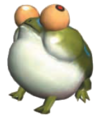
|
Frogs that inflate whenever the Sound Wave Attack is used on them. |
| Birimēra | File:Birimēra.PNG | Small jellyfish that can be defeated with the Sound Wave Attack. |
| Puchimēra | File:Puchimēra.PNG | Jellyfish that are immune to any attacks. |
| Ninjape | 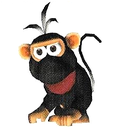
|
Ninja monkeys that come in several colors and attack in a variety of ways. |
| Yukimogura | File:Yukimogura.PNG | Furry, spiked enemies that act as obstructions. |
| Black Butapokkī | File:Black Butapokkī.PNG | Small black Hawgs that can be defeated with a single punch. |
| White Butapokkī | File:White Butapokkī.PNG | Small white Hawgs that can be knocked into the air and punched into other enemies. |
| Kobukokko | File:Kobukokko.PNG | A large chicken enemy that takes several hits to defeat. |
| Snowman | 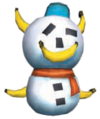
|
Snowmen that can be defeated in a single hit. |
| Dance Spider | File:Dance Spider.PNG | Large spiders that move back and forth and take several hits to defeat. |
| Cocopī | 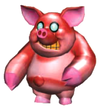
|
Pigs that sit in a tree and throw coconuts at Donkey Kong. |
| Karikari | File:Karikari.PNG | Small rodents that latch on to Donkey Kong. |
| Kamikami | File:Kamikami.PNG | Poisonous rodents that latch on to Donkey Kong and deplete his beat total. |
| Hatchī | File:Hatchī.PNG | Bee enemies that can be attacked with the Sound Wave attack, making them smaller. |
| Hatchīfu | File:Hatchīfu.PNG | Large Hatchī that take several hits to defeat. |
| Stinger | File:Stinger.PNG | Wasp enemies that fly after Donkey Kong and can be defeated with the Sound Wave Attack. |
| Armored Stinger | File:Armor Stinger.PNG | Stingers in metal armor that cannot be defeated with a single attack; using the Sound Wave Attack turns them into regular Stingers. |
| Haribonbon | File:Haribonbon.PNG | Fish that swim around a given area and defend themselves with retractable spikes. |
| Template:Conjecturaltext | 
|
A panda-like enemy that dances around and has its own Sound Wave Attack. |
| Template:Conjecturaltext | File:DKJB Stone Ghost.png | A large, stone ghost-like enemy that spits projectiles back and forth. |
| Template:Conjecturaltext | 
|
A very large piranha similar to the ghost enemy that spits a projectile back and forth. |
| Template:Conjecturaltext | 
|
A round lizard enemy that rolls around in a set area and can be stunned by attacking its front with the Sound Wave Attack. |
| Template:Conjecturaltext | 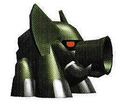
|
Small Tusk-like cannons that fire singular cannonballs. |
| Template:Conjecturaltext | 
|
Red birds that drop pineapples that can be thrown back at them. |

|
Large, black birds that fly above in Hoofer levels; in Iguanagon's Realm they attack by dropping spiked balls. | |

|
Golden birds that only appear in Iguanagon's Realm and do not attack. |
"New Play Control!" series
- Main article: New Play Control! Donkey Kong Jungle Beat
In 2008/2009, Donkey Kong Jungle Beat was ported to the Wii as part of the New Play Control! series of games, a series of GameCube games remade to take advantage of the Wii's motion controls. In addition to the new control style, the port also features new levels, additions and changes to the existing stages, and some gameplay mechanics having been altered from the original version to accommodate the change in controls.
Derivatives
In Japan, two Donkey Kong Jungle Beat-themed medal games were developed by Capcom and released on Sega's Triforce line of arcade machines:
- Donkey Kong: Jungle Fever (2005)
- Donkey Kong: Banana Kingdom (2006)
Development
- “Our manual writer had an easy job on this one.[1]”
- —Takao Shimizu
Development on the game started after after director Yoshiaki Koizumi and producer Takao Shimizu attended a meeting featuring the bongo controller developed for Donkey Konga[2]. The team spent some time thinking of mechanics that would fit the controller.
After working on several titles using a traditional controller, Koizumi wanted to make something a different input method. He also heard various complaints that controls in contemporary games were becoming too complex[2] and thus desired to develop a simpler game. As such, he was pleased when the game's E3 2004 demo was well-received by female and "casual" players [2].
The development team wanted to keep the game's mechanics and presentation as simple as possible to appeal to players intimidated by the complexity of modern games[1]. Characters from previous Donkey Kong games except Donkey Kong himself and "the banana" (whom Yoshiaki Koizumi apparently considered to be a character) were ignored, as EAD Tokyo felt the aesthetics of the series were not "fresh enough"[1].
Promotion
Nintendo sent out fifty people dressed in gorilla costumes to compete in the Los Angeles Marathon on March 6, 2005, to promote Donkey Kong Jungle Beat. Several of said runners were wearing Donkey Kong Jungle Beat-themed t-shirts and sweatbands, and some were also carrying DK Bongos.[3]
Reception and legacy
At release, Donkey Kong Jungle Beat was well received by critics. The game's main criticisms were its short length and departure from the classic Donkey Kong Country gameplay, as well as a lack of replay value. Donkey Kong Jungle Beat mainly received praise for its advanced graphics, as well as for the unique use of the DK Bongos controller, which many critics called innovative. The game was rated the 95th best game made on a Nintendo system in the Top 200 Games List by Nintendo Power in its February 2006 issue, and in the final issue the game was rated 130 in the 285 best Nintendo games of all time list.[4] EAD Tokyo would also use the experience from developing this game when they went on to develop Super Mario Galaxy[5].
| Reviews | |||
|---|---|---|---|
| Reviewer, Publication | Score | Comment | |
| Matt Casamassina, IGN | 8.8/10 | "Jungle Beat is a surprisingly addictive and well-made platformer with a unique control twist. Anybody who says differently either didn't take the time to really play it or has no business playing games." | |
| Jeff Gerstmann, GameSpot | 7/10 | "Overall, Donkey Kong Jungle Beat is a scream...for the first eight levels. Once you've seen what the game has to offer, though, there's not a lot to come back to. Anyone with moderately developed action game skills will finish this game in one day, probably without actually dying once. That makes this a rental, at best, but if you're shopping for young children that like to smack stuff, or if you already picked up the bongo drums and are desperate for anything else that uses them, you could make a case for adding this one to your permanent collection." | |
| Brett Elston, GamesRadar | 4/5 | "Nintendo’s Revolution is promising something crazy unique, but for now the bongo controllers offer enough gameplay diversity to show that the innovator has its heart in the right place: making games accessible and exciting for everyone. Jungle Beat may be the only game to make good use of the bongos, but it does one hell of a job." | |
| Tom Bramwell, Eurogamer | 8/10 | "But, as we glance around for a cymbal to cap things off, it would be cruel to hold these things against Donkey Kong Jungle Beat. Nintendo's burgeoning Revolution means it's barely even the most innovative 2D platform game we've played this month, but compared to the last two decades' output it's gloriously refreshing, and it's only the lack of longevity that leads us to hesitate in recommending it. If you can stomach the cost though, you'll soon see that it's far more than a gimmiEEEEOWWW. A suitable drumroll for the Revolution, then." | |
| Game Informer | 7.5/10 | "A gorgeous game with a couple examples of spectacular level design, but it doesn't have any tricks up its sleeve once the novelty wears off." | |
| Aggregators | |||
| Compiler | Platform / Score | ||
| Metacritic | 80 | ||
| GameRankings | 81 | ||
References to other games
- Donkey Kong: At the very beginning of the Cactus/Ghastly King battles, part of the music that plays is a remix of the tune that plays when Donkey Kong climbs atop the construction site with Pauline.
- Donkey Kong Country: The entire concept of collecting bananas and riding Jungle Buddies originated from this game. Additionally, the background music that plays in Dawn Savanna, after clearing any boss stage, and the ending are remixes of the Jungle Hijinxs theme. Lastly, voice clips from Funky Kong's theme can be heard towards the end of the Opening Ceremony.
References in later games
- Mario Kart DS: Many of Donkey Kong's voice clips from Donkey Kong Jungle Beat are reused for this game.
- DK: Jungle Climber: Many voice clips from this game are reused. Also, the pose that Donkey Kong strikes after completing the bonus stage (where the player has to catch bananas with a barrel) is identical to the pose that he strikes in Jungle Beat after completing the banana-eating bonus at the end of each stage.
- Super Mario Galaxy: Several gameplay mechanics and elements from Donkey Kong Jungle Beat are reused in this game, including sound effects. Several assets from this game have also been found that go unused in the final game.
- Super Smash Bros. Brawl: Rumble Falls is a default stage that can be selected in the game, and the background also changes rapidly, with one of them being the background that was used in the Sky Garden stage. Also, the song, "Battle For Storm Hill", in its original form, may be selected as background music for that stage and custom stages. Lastly, the Party Monkey, Gale Hawg, Hoofer, Karate Kong, and Donkey Kong's appearance in this game appear as Stickers, and Helibird and Turrent Tusk appear as Trophies.
Gallery
- Donkeykongnew.jpg
Glitches
Template:Conjecturaltext
By clapping on every frame while on a wall, the player can slide up the wall. Additionally, the player's momentum increases for every clap, causing them to speed away if the player reaches the top of the wall or jumps off of it, similar to the backwards long jump in Super Mario 64.[6]
Template:Conjecturaltext
By defeating one of the two Double Tusks with an attack that brings the total HP of both down to zero, both Tusks are destroyed, but the "enraged" animation (when a boss' HP is below half) for the one that is destroyed second plays instead of the "victory" animation (though the music and sound effects still play).[7]
Pre-release and unused content
In the E3 2004 demo, the Party Monkeys are shown to be normal brown monkeys, similar in appearance to Donkey Kong. The Dread Kong boss did not exist, the stand-in boss being a grey clone of Donkey Kong. Most of Donkey Kong's voice clips for the demo were also reused from Donkey Kong 64.
Staff
- Main article: List of Donkey Kong Jungle Beat staff
Donkey Kong Jungle Beat was the first game developed by Nintendo EAD's Tokyo division, which would later go on to develop every 3D Super Mario game starting with Super Mario Galaxy. The game's producer was Takao Shimizu, the manager of EAD Tokyo Group No. 1, and it was directed by Yoshiaki Koizumi, the manager of Group No. 2, both of whom had been a part of development of several previous Mario games. The music was composed by Mahito Yokota, who later collaborated with other Nintendo staff to compose the soundtracks for various other Nintendo games. Donkey Kong's voice clips were provided by his current voice actor Takashi Nagasako, this being his first game.
Name in other languages
External links
References
- ^ a b c d NSider translation of an interview (original Japanese interview available here)
- ^ a b c IGN: Donkey Kong Jungle Beat
- ^ Casamassina, Matt (March 8, 2005.) Apes Run Rampant. IGN. Retrieved November 1, 2014.
- ^ Brain (December 12, 2012). Nintendo Power ranks the top 285 Nintendo games of all time. Nintendo Everything. Retrieved October 13, 2014.
- ^ Iwata Asks: Super Mario Galaxy (accessed March 07 2012)
- ^ Donkey Kong Jungle Beat TAS Banana Kingdom. Posted to YouTube by BlunderstabTAS (February 3, 2013). Retrieved November 1, 2014.
- ^ Donkey Kong Jungle Beat TAS Chili Pepper Kingdom. Posted to YouTube by BlunderstabTAS (August 11, 2014). Retrieved November 1, 2014.
